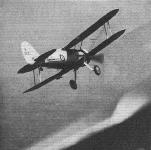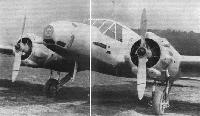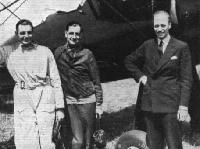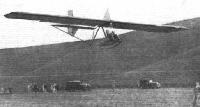Фотографии
-
Регистрационный номер: K2124 The "Hart" light bomber has one fixed gun in front, fired by the pilot who has to aim the whole machine. The rear gun is movable and protects the zone above, that to the rear, except where masked by the tail, and over a wide arc below on each side. There is a blind spot immediately beneath the machine.
Самолёты на фотографии: Hawker Hart - Великобритания - 1928
-
Регистрационный номер: K2434 "Dagger III" engines destined to equip one squadron of Hawker "Audax" Army co-operation machines are being built at the Napier works. Here a "Dagger" is shown installed in a "Hart." The "Audax" installation will be slightly different.
Самолёты на фотографии: Hawker Hart - Великобритания - 1928
-
Регистрационный номер: G-ADLO Mrs. Miles and Mr. F. G. Miles flying the new De Luxe "Hawk Major" near Reading.
Самолёты на фотографии: Miles Hawk / M.2 - Великобритания - 1932
-
This Miles "Falcon," with tandem seating, has been entered for the King's Cup by Viscountess Wakefield, and will be flown by Flt. Lt. "Tommy" Rose.
Самолёты на фотографии: Miles Falcon M.3 / Hawcon M.6 - Великобритания - 1934
-
Самолёты на фотографии: Maurice Farman MF.7 Longhorn - Франция - 1912
-
No. 10 (BOMBER) SQUADRON. A flight of five Handley-Page "Heyfords" flying in formation by day. Last week the squadron made night raids on Portsmouth and was very successful in evading the searchlights.
Самолёты на фотографии: Handley Page Heyford / H.P.38 / H.P.50 - Великобритания - 1930
-
Handley Page "Heyfords" will appear in service with 600 h.p. "Kestrels," enclosed pilots' cockpits and other refinements. The speed should be in the neighbourhood of 150 m.p.h
Самолёты на фотографии: Handley Page Heyford / H.P.38 / H.P.50 - Великобритания - 1930
-
The Handley Page "Heyford" heavy bomber has one gun position in the nose, a second gun above the fuselage behind the wings, and a revolving turret which can be lowered underneath the fuselage. It would be difficult to find a blind spot.
Самолёты на фотографии: Handley Page Heyford / H.P.38 / H.P.50 - Великобритания - 1930
-
Регистрационный номер: J9186 The Boulton Paul "Overstrand" medium bomber has a very efficient revolving gun turret in the nose, commanding a complete hemisphere. The gunner is also the bomb-aimer. Behind the wings are two gun positions, one for firing upwards and the other below the fuselage for firing downwards and rearwards, but there is only one gunner for these two guns.
Самолёты на фотографии: Boulton Paul Overstrand / P.75 - Великобритания - 1933
-
A RECORD HOLDER. The Italian Cant. 501 flying boat which, as already recorded in Flight, flew from Montfalconeto Berbera, a distance of 3,104 miles in 24 hr. 55 min. thus setting up a new world's non-stop record for seaplanes. The engine is a 750 h.p. Isotta Fraschini.
Самолёты на фотографии: CANT Z.501 Gabbiano - Италия - 1934
-
Регистрационный номер: K5200 The Gloster F.7/30, now known as the "Gladiator," is the latest fighter to be ordered for the R.A.F. Four guns are carried, two in the fuselage and the other pair beneath the lower main planes.
Самолёты на фотографии: Gloster Gladiator - Великобритания - 1934
-
Регистрационный номер: K4094 No. 19 (Fighter) Squadron flying its "Gauntlet Is." The latest type of "Gauntlet" differs in certain ways from this mark, but the variations, which are of a structural nature, are not externally obvious.
Самолёты на фотографии: Gloster Gauntlet - Великобритания - 1929
-
The Vickers "Vincent'' ("Pegasus IIM"), seen here with its long-range tank in position, is now being issued to a number of units overseas
Самолёты на фотографии: Vickers Vincent / Type 266 - Великобритания - 1932
-
Регистрационный номер: K1757 Fairey "Gordons" flying over a remarkably solid-looking "cotton-wool carpet" while on a raid during the Air Exercises.
Самолёты на фотографии: Fairey Gordon / Seal - Великобритания - 1931
-
Attack by a two-seater Hawker "Demon" on a Fairey "Gordon" light bomber. The fighter uses its rear gun from a blind spot under the bomber's nose. The bomber has one fixed front gun, which can only be brought to bear by dipping the nose of the machine. This form of attack can be used by a formation as well as by a single fighter.
Самолёты на фотографии: Fairey Gordon / Seal - Великобритания - 1931Hawker Demon - Великобритания - 1932
-
There will be at least three squadrons of Saro "Londons." These are very sturdy boats with two 690 h.p. "Pegasus III's."
Самолёты на фотографии: Saunders-Roe London / A.27 - Великобритания - 1934
-
Регистрационный номер: K4577 The Short "Singapore III" powered with four 525 h.p. "Kestrels" has a speed of 145 m.p.h. Boats of this type are now going into service with squadrons overseas.
Самолёты на фотографии: Short Singapore III / S.19 - Великобритания - 1934
-
The "Stranraer" (two Bristol "Pegasus") making an overland journey
Самолёты на фотографии: Supermarine Stranraer - Великобритания - 1934
-
Самолёты на фотографии: Supermarine Stranraer - Великобритания - 1934
-
A bird's-eye view of the "Stranraer" alighting on the water.
Самолёты на фотографии: Supermarine Stranraer - Великобритания - 1934
-
Регистрационный номер: K3973 "Pegasus X" engines of 820 h.p. will power the Supermarine "Stranraer." This flying boat has an exceptionally fine all-round performance.
Самолёты на фотографии: Supermarine Stranraer - Великобритания - 1934
-
Stern Defence: The rear gunner's cockpit in the "Stranraer." Note also the control "tabs" on rudders and elevator.
Самолёты на фотографии: Supermarine Stranraer - Великобритания - 1934
-
The interior accommodation ot the "Stranraer." On the left, is a view looking towards the pilots' cockpit and forward gun station. The navigator and engineer are accommodated in the compartment ait of the pilots' cockpit. On the right, a view looking towards the tail.
Самолёты на фотографии: Supermarine Stranraer - Великобритания - 1934
-
SLOTTED: An example of the 135 Curtiss O3C-1 scout observation biplanes ordered by the U.S. Navy. The machine is here seen equipped for carrier operation, but it may be employed as a seaplane if necessary. Handley-Page slots account for the excellent speed range of the type.
Самолёты на фотографии: Curtiss SOC Seagull - США - 1934
-
"Anson" is the official name of the Avro coastal reconnaissance monoplane (2 "Cheetah IX"). A very large order for these machines has been placed.
Самолёты на фотографии: Avro Anson / Type 652 - Великобритания - 1935
-
Регистрационный номер: K4190 One of two torpedo spotter reconnaissance types to be adopted is the Fairey "Swordfish" with 690 h.p. "Pegasus III."
Самолёты на фотографии: Fairey Swordfish - Великобритания - 1934
-
The Lord Mayor, Aid. R. S. Dalgliesh, welcomes Sir Philip Cunliffe-Lister as he steps from the Communications "Rapide."
Самолёты на фотографии: De Havilland Dragon Rapide / Dominie / D.H.89 - Великобритания - 1934
-
The Vickers "Valentia" is an improved "Victoria" with "low duty" "Pegasus" engines. The performance is considerably improved.
Самолёты на фотографии: Vickers Valentia - Великобритания - 1934
-
Filling up the new K.N.I.L.M. Douglas with Shell 87-octane fuel.
Самолёты на фотографии: Douglas DC-1 / DC-2 / C-32 / C-39 - США - 1933
-
A Douglas D.C.2 recently delivered to K.N.I.L.M. being assembled at the Dutch naval aerodrome at Surabaya
Самолёты на фотографии: Douglas DC-1 / DC-2 / C-32 / C-39 - США - 1933
-
THE HIDE-OUT: A friend of ours, of a retiring nature, having discovered in the German journal Luftwehr this crew-station diagram for a Fokker-Douglas D.C.2 bomber, has definitely decided on the position he would like to occupy in the event of finding himself in a heavy bomber squadron in the next war.
Самолёты на фотографии: Douglas DC-1 / DC-2 / C-32 / C-39 - США - 1933
-
Регистрационный номер: K4798 INSTRUCTOR AND PUPIL: An Avro "Tutor" of the Oxford University Air Squadron flying along the Kentisn coast, with Whitstable in the background.
AVRO TUTOR: Trainer (Lynx IVC engine - 240 h.p. at sea level); span, 34ft.; gross weight, 2,458 lb.; max. speed, 122 m.p.h.Самолёты на фотографии: Avro Tutor/Sea Tutor/Prefect / Type 621/646/626 - Великобритания - 1929
-
FROM ISIS TO SWALE: The Oxford University Air Squadron is now encamped at Eastchurch in the isle ol Sheppey, and its Avro "Tutors" range over the waters of the Thames estuary. Here a flight is seen over a line of red-sailed barges which have just emerged from the Swale channel.
Самолёты на фотографии: Avro Tutor/Sea Tutor/Prefect / Type 621/646/626 - Великобритания - 1929
-
Whitstable as seen from the air, with a flight of the Oxford "Tutors" coasting along.
Самолёты на фотографии: Avro Tutor/Sea Tutor/Prefect / Type 621/646/626 - Великобритания - 1929
-
Регистрационный номер: VH-URT THE BASS STRAIT SERVICE: One of Holyman's Airways' D.H. 86s used on the service between Melbourne, Launceston and Hobart.
Самолёты на фотографии: De Havilland Express Air Liner / D.H.86 - Великобритания - 1934
-
CAIRO "EXPRESS": Misr Airwork's first D.H.86 ("Express") photographed by a "Shell" representative in front of its new quarters at Almaza aerodrome. During its delivery journey Mr. Roderick Denman, a director of Airwork, Ltd., acted as radio operator.
Самолёты на фотографии: De Havilland Express Air Liner / D.H.86 - Великобритания - 1934
-
The Fairey "Hendon" heavy bomber not only has one gun position in the nose and one behind the wings firing upwards, but also one behind the rudders which commands a complete hemisphere.
Самолёты на фотографии: Fairey Hendon - Великобритания - 1930
-
In its production form the Fairey "Hendon" will have 600 h.p. "Kestrels," a cupola for the front gunner, and an enclosed pilot's cockpit.
Самолёты на фотографии: Fairey Hendon - Великобритания - 1930
-
No. 23 (Fighter) Squadron, which was the first unit to receive the "Demon" two-seater fighter, is here seen breaking from an echelon formation. Future "Demons" will have the 600 h.p. "Kestrel V."
Самолёты на фотографии: Hawker Demon - Великобритания - 1932
-
Mr. A. E. Morrod's Percival "Gull" without its fabric.
Самолёты на фотографии: Percival Gull - Великобритания - 1932
-
The "Gull" in its finished state. The span is 7ft. 8in., length 5ft. 3 1/2in. and weight with coil and battery, 6 1/2 lb. The engine is a 15C.C. two-stroke.
Самолёты на фотографии: Percival Gull - Великобритания - 1932
-
The "T.K.2" before it received its final coat of paint. It is also minus its spats.
Самолёты на фотографии: De Havilland Technical School T.K.2 - Великобритания - 1935
-
A general view of the "T.K.2" in skeleton. Note shallow depth of fuselage primary structure. The decking is a light structure of formers and stringers, covered with fabric.
Самолёты на фотографии: De Havilland Technical School T.K.2 - Великобритания - 1935
-
Details of the wing construction. The primary structure is in the form of a box, comprising the two main spars and the plywood covering. Leading and trailing edge ribs are then attached to this box. Details of spar joints, etc., are also shown.
Самолёты на фотографии: De Havilland Technical School T.K.2 - Великобритания - 1935
-
General fuselage construction. The wing is offered up to the recess and held by four joints. The spars form supports for seats and controls.
Самолёты на фотографии: De Havilland Technical School T.K.2 - Великобритания - 1935
-
The oil tank is built into the leading edge of the port wing root. One of the four bolted joints which secure wing to fuselage is also shown, as well as the attachment of the undercarriage leg to the front spar.
Самолёты на фотографии: De Havilland Technical School T.K.2 - Великобритания - 1935
-
T.K.II Gipsy Major Engine
Самолёты на фотографии: De Havilland Technical School T.K.2 - Великобритания - 1935
-
Регистрационный номер: OK-PGA COMPACT: The Praga 114 cabin two-seater, with 36 h.p. air-cooled flat-twin engine, which was demonstrated by Mr Kostalek at Heston last week. The machine sells in Czechoslovakia for about ?380.
Самолёты на фотографии: Praga E-114 Air Baby / E-115 / E-117 - Чехословакия - 1934
-
Mr. Hansez in the Caudron "Simoun" crossing the finishing line to win the Cinque Ports Wakefield Cup race.
Самолёты на фотографии: Caudron C.500 / C.520 / C.620 / C.630 Simoun - Франция - 1934
-
Регистрационный номер: D-ETIS A group of the visiting German aeroplanes. On the right is the "Stieglitz" in which Herr Furster aerobatted so efficiently.
Самолёты на фотографии: Focke-Wulf FW.44 Steiglitz - Германия - 1932
-
THE LATEST IN FAIRCHILDS. This is the new Fairchild "45" five-seater monoplane, which might be regarded as America's reply to our Airspeed "Courier." The engine is one of the new 225 h.p. Jacobs radials and gives a top speed of 160 m.p.h. With flaps down - they are of the split type - the landing speed is 48 m.p.h.
Самолёты на фотографии: Fairchild Model 45 - США - 1935
-
BRITISH PARTICIPANTS in last week's Tour of Holland - Mr. J. R. Ashwell-Cooke and Major H. Petre leaving the latter's "Puss Moth" in company with Mr. H. J. Tjarda, of the Amsterdam Aero Club. Another English competitor, Mr. Presland, tied for first place with a Polish pilot.
Самолёты на фотографии: De Havilland Puss Moth / D.H.80 - Великобритания - 1929
-
A large number of "Wallaces" with enclosed cockpits are under construction at the Westland works.
Самолёты на фотографии: Westland Wallace / PV.3 / PV.6 - Великобритания - 1931
-
Регистрационный номер: G-ADEF [3] THE NEW D.H. "COMET" with which Mr. T. Campbell Black hopes shortly to make three long-distance record flights - to Cape Town and back in five days, England to Hong Kong in five days, and Canada and back in a week-end. The new machine derives a cruising speed of 220 m.p.h. from its two special "Gipsy Sixes" and has a range approaching 3,000 miles. Seen beside it are Mr. Black and Mr. Nicholson, the sponsor of the attempts.
Самолёты на фотографии: De Havilland Comet / D.H.88 - Великобритания - 1934
-
Регистрационный номер: G-ADEF [3] BOOMERANG: Last Thursday, shortly before Mr. Campbell Black and Mr. McArthur left Hatfield in an attempt to fly to Capetown and back in record time, the "Comet" was named Boomerang by Lady Fielding. Seen in front of the machine are (left to right) Mr. Cyril Nicholson, who is sponsoring the flight. Lady Fielding, Mr. J. H. McArthur, Mrs. Campbell Black and Mr. T. Campbell Black. The flight was abandoned at Cairo owing to a shortage of lubricating oil. A further attempt will be made very shortly, and it is hoped to cover the 7,300-mile journey with only two stops for fuel, at Cairo and Kisumu.
Самолёты на фотографии: De Havilland Comet / D.H.88 - Великобритания - 1934
-
Регистрационный номер: G-ADEF [3] The D.H. Comet with two Gipsy Six R engines is perhaps the most successful long-distance racing type of recent years.
Самолёты на фотографии: De Havilland Comet / D.H.88 - Великобритания - 1934
-
Самолёты на фотографии: Avro Type 636/667 - Великобритания - 1935
-
Looked at from the side, the Avro 636, except for the cantilever undercarriage, gives little hint of its outstanding performance.
Самолёты на фотографии: Avro Type 636/667 - Великобритания - 1935
-
A head-on view shows where some of the performance comes from - the undercarriage is as clean as possible.
Самолёты на фотографии: Avro Type 636/667 - Великобритания - 1935
-
This view of the Avro 636, one of those shortly being delivered to the Irish Free State Air Force, shows that the occupants of both cockpits have an excellent outlook.
Самолёты на фотографии: Avro Type 636/667 - Великобритания - 1935
-
Three well-known Avro personalities with the new "636": Flt. Lt. F. B. Tomkins, Mr. "Bill" Thorn and Mr. C. J. Wood.
Самолёты на фотографии: Avro Type 636/667 - Великобритания - 1935
-
Exceptionally roomy cockpits are a feature of the Avro 636. Adjustable seats and rudder bars make the flying position comfortable for any pilot.
Самолёты на фотографии: Avro Type 636/667 - Великобритания - 1935
-
Регистрационный номер: K7557 [2] BRITAIN FIRST: The Bristol 140 civil monoplane, which has been presented to the Air Ministry by Lord Rothermere, coming in to land at Filton aerodrome. With two Bristol "Mercury" VI S engines the top speed is reputed to be in the region of 270 m.p.h.
Самолёты на фотографии: Bristol Type 142 Britain First / Type 143 - Великобритания - 1935
-
Регистрационный номер: K7557 [2] HIGH SPEED: The clean lines of the all-metal Bristol 142 are obvious in this view, which also shows the trimming tabs on the rudder and ailerons.
Самолёты на фотографии: Bristol Type 142 Britain First / Type 143 - Великобритания - 1935
-
Регистрационный номер: NC14714 AMERICA'S LATEST: Recently reported as having made the 2,100 mile flight between Alameda, California, and Honolulu in 17 hr. 9 min., this Glenn Martin "Flying Clipper," which forms part of the new Pan American equipment, has cut the previous time for the journey by 50 min. The engines are Pratt and Whitney Twin "Wasps" driving constant-speed Hamilton Standard airscrews. Passenger accommodation is for about 46.
Самолёты на фотографии: Martin China Clipper / Type 130 - США - 1934
-
AROUND THE WORLD NON-STOP? A "nose-on" view of the Burnelli UB 14 in which Clyde Pangborne hopes to make an attempt to fly around the world, refuelling from other aircraft on the way. A feature of the machine is the aerofoil section fuselage. Note the pilots' position.
Самолёты на фотографии: Burnelli UB-14 - США - 1934
-
CLYDE PANGBORN with the new Burnelli fourteen-passenger U.B.14 transport. With two Pratt & Whitney "Hornet" engines, a cruising speed of over 200 m.p.h. is claimed.
Самолёты на фотографии: Burnelli UB-14 - США - 1934
-
Регистрационный номер: F-AODN FOUR CAUDRON "TYPHONS," of the type shown here, have been ordered by the French Government for experiments with long range, highspeed mail carrying. The cruising speed, with two six-cylinder Renaults driving Ratier V.P. airscrews, is 202 m.p.h.
Самолёты на фотографии: Caudron C.640 Typhoon - Франция - 1935
-
Pilotes of a Fleet Air Arm squadron which took part in the Air Exercises; the machines are Hawker "Nimrods" and "Ospreys."
Самолёты на фотографии: Hawker Nimrod - Великобритания - 1931
-
Регистрационный номер: K2911 Arrester gear is as old in its conception as the idea of landing on the deck of an aircraft carrier, though the early forms, which made use of sandbag-weighted ropes, did not prove very successful; consequently these systems were gradually dropped in the Fleet Air Arm as the technique of landing on a bare deck was improved. More recently other countries, America in particular, have revived forms of arrester gear, presumably on the score of higher landing speeds, and our photographs show the latest type of arrester gear which is being used by our own Naval air service. The pivoted hook under the rear end of the fuselage catches in the cables stretched across the deck.
Самолёты на фотографии: Hawker Nimrod - Великобритания - 1931
-
Регистрационный номер: G-ACTC What happened when Mr. Duncanson had to land the Hendy "Heck" at Hanworth with its wheels retracted.
Самолёты на фотографии: Parnall Hendy Heck - Великобритания - 1934
-
NASAL: The nose of America's largest and, we are told, fastest bomber, the Boeing 299. The machine has flown 2,300 miles in nine hours. The engines are Pratt and Whitney "E" type "Hornets," which yield 750 h.p. apiece, and the airscrews are of the Hamilton "constant speed" variety.
Самолёты на фотографии: Boeing B-17 Flying Fortress - США - 1935
-
Регистрационный номер: X13372 THE BIG BOEING BOMBER: This photograph shows the new Boeing 299 in its completed state. Its gross weight is said to be 30,000 lb., its bomb load six tons, top speed 250 m.p.h., ceiling 25,000 ft. and range without refuelling 2,500 miles. The construction is termed "three-ply all-metal." The engines are four Pratt and Whitney.
Самолёты на фотографии: Boeing B-17 Flying Fortress - США - 1935
-
PORTRAIT OF A PIONEER : A remarkable photograph of M. Henri Mignet flying his "Pou-du-Ciel."
Самолёты на фотографии: Mignet Pou-de-Ciel / HM-14 - Франция - 1932
-
1909-1935! As then so now, a French pioneer crosses the Channel in a machine of his own creation. At. Henri Mignet in his "Pou-du-Ciel" approaching Folkestone on August 13th.
Самолёты на фотографии: Mignet Pou-de-Ciel / HM-14 - Франция - 1932
-
A Pioneer's "Pou." M. Henri Mignet, designer, or, one might say, inventor, of the "Pou-du-Ciel" with his personal machine. The engine is an Aubier et Dunne.
Самолёты на фотографии: Mignet Pou-de-Ciel / HM-14 - Франция - 1932
-
Регистрационный номер: G-ADMH - and landed in an allotment just outside. The plough furrows proved his undoing. On grass he would probably have landed safely. Even as it was, surprisingly little damage was done.
Самолёты на фотографии: Mignet Pou-de-Ciel / HM-14 - Франция - 1932
-
M. Mignet "trundling" his "Pou" on Lympne aerodrome. The engine is an Aubier et Dunne two-stroke.
Самолёты на фотографии: Mignet Pou-de-Ciel / HM-14 - Франция - 1932
-
On the left our artist shows a side view ol the cockpit, with the engine controls and fuel supply arrangements; on the right is the roomy cockpit with its instrument lay-out and pilot's seat.
Самолёты на фотографии: Mignet Pou-de-Ciel / HM-14 - Франция - 1932
-
(Centre) the simple undercarriage springing; (left) the sprung strut which supports the trailing edge of the front wing; (right) the springing and operation of the sternpost with rudder and double tail wheel.
Самолёты на фотографии: Mignet Pou-de-Ciel / HM-14 - Франция - 1932
-
Регистрационный номер: G-ABWL Самолёты на фотографии: De Havilland Gipsy Moth / Moth X - Великобритания - 1928
-
Регистрационный номер: OE-TIE The very last of the open D.H. "Moths" - destined for the Austrian Aero Club.
Самолёты на фотографии: De Havilland Gipsy Moth / Moth X - Великобритания - 1928
-
Mr. J. P. Dewsbury soaring over Totternhoe in a Kassel two-seater.
Самолёты на фотографии: Kassel Kassel 25 / 20 - Германия - 1930
-
Mr. C. Nicholson piloting the "Rhon Buzzard" an efficient German-built sailplane.
Самолёты на фотографии: Schleicher Rhonbussard - Германия - 1933
-
Регистрационный номер: NS13 SAFETY FIRST: The more important features of the tailless Waterman "Arrowplane" can be seen in this photograph.
Самолёты на фотографии: Waterman Arrowplane / W-4 - США - 1935
-
A "Dagling" primary trainer which the London Gliding Club has made more efficient by fitting a nacelle around the pilot.
Самолёты на фотографии: Slingsby T.3 Dagling - Великобритания - 1930
-
A member of the Summer Camp making a "ground-hop" in a "Dagling."
Самолёты на фотографии: Slingsby T.3 Dagling - Великобритания - 1930
-
The Miles "Hawk M.5," which, entered by Mr. G. A. Hebden, will be flown by Mr. F. G. Miles. This machine is a standard two-seater, but has a reduced wing area, faired-in front cockpit and high-compression "Gipsy Six" engine.
Самолёты на фотографии: Miles Sparrowhawk / M.5 - Великобритания - 1935
Статьи
- Flight























































































